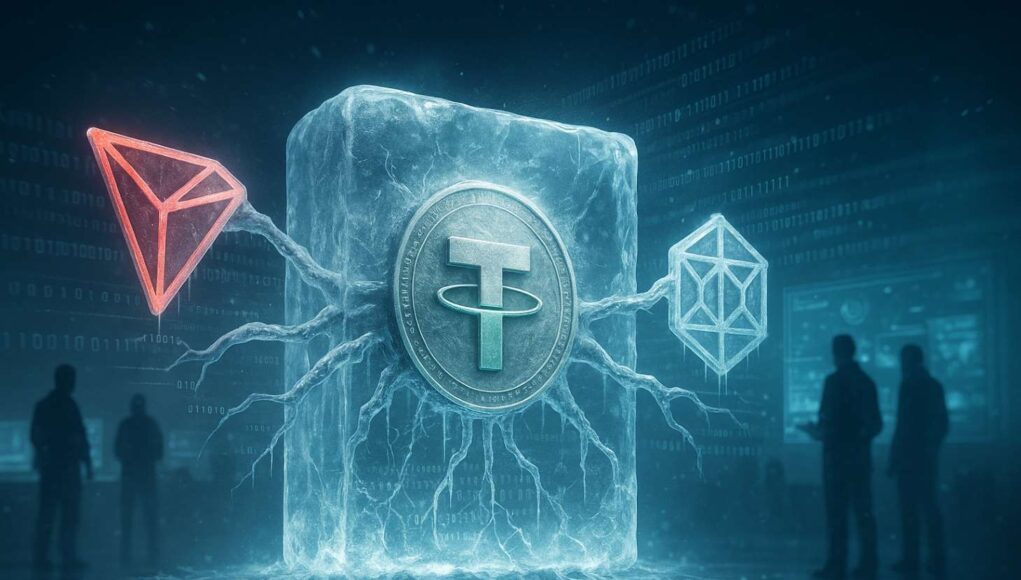A year after its launch, the Tether – TRON – TRM Labs Financial Crime Unit (T3) says it has now frozen more than $300 million in illicit crypto assets. It’s one of the industry’s largest coordinated anti-crime efforts to date. The milestone, announced in Tether’s latest update, reflects both the scale of fraud moving across stablecoin networks and a growing willingness among crypto companies to police their own infrastructure before regulators do it for them.
Inside T3 — How T3 Freezes Illicit Crypto Funds
The T3 Financial Crime Unit was founded by Tether, TRON, and blockchain-intelligence firm TRM Labs to trace and immobilize stolen or criminally obtained digital assets. Its method is simple in theory but complex in execution. It requires continuous on-chain surveillance, data sharing between private actors, and real-time coordination with law-enforcement agencies.
In August 2025, T3 expanded its reach through T3+, a collaborator program that allows exchanges and analytics companies to join its network. Binance became the first participant, working with investigators to identify and freeze roughly $6 million in pig-butchering scam proceeds. That case showed the system’s effectiveness. Suspicious wallets were flagged in hours rather than weeks. T3 neutralized criminal liquidity before it could vanish into mixers or offshore OTC desks.
The crime unit functions almost like a financial intelligence agency built directly on-chain. Instead of subpoenas and bank statements, T3’s analysts rely on address clustering, token flow heuristics, and wallet-behavior patterns provided by TRM Labs’ risk engine.
>>> Read more: Tether freezes $225 mln USDT linked to crypto crimes
Following the Rails — Why TRON and USDT Matter
If most crypto crime follows the money, then much of that money runs on the USDT TRON network. With its near-zero transaction fees and massive daily volume, TRON has become the preferred rail for low-cost stablecoin transfers. Hence, it inevitably became a haven for laundering operations.
TRM Labs’ prior intelligence reports show that scammers and ransomware groups increasingly route funds through TRON-based USDT because it offers speed and anonymity at scale. A typical flow starts with scam victims sending funds to fraudulent investment platforms. Operators convert them to USDT, move them across hundreds of TRON wallets to obfuscate origin, and finally off-ramp through loosely regulated brokers.
For investigators, this stablecoin crime crackdown is less about any single blockchain and more about closing the gaps between them. T3’s progress indicates that cooperation between issuers and network operators can actually freeze funds in real time. That’s something governments have long struggled to do.
>>> Read more: Circle Cuts Ties: USDC Exits TRON Blockchain
The Milestone in Context — From $250 Million to $300 Million
When T3 launched T3+ in August, it had already locked down $250 million in frozen crypto assets. Just two months later, the figure rose to $300 million. The speed of new seizures suggests both improved tracking capabilities and an alarming persistence of fraud.
The blocked assets span romance scams, investment fraud, phishing campaigns, and laundering pipelines stretching across Asia, Europe, and North America. Each freeze requires verification that the tokens were criminally linked. This labor-intensive process involves blockchain analytics, cooperation from exchanges, and in some cases direct law-enforcement warrants.
These operations prove that industry-led crypto enforcement can work faster than formal regulation. It appears to be a necessary argument as stablecoin issuers fight for credibility under emerging global rules.
The Hard Part — From Freeze to Recovery
Still, freezing is the easy part. Can victims recover frozen USDT? The short answer: rarely, at least not yet. Once assets are immobilized, they remain in limbo until courts issue seizure or restitution orders. Unfortunately, such a process can take months or years.
Legal complexity multiplies when funds cross jurisdictions. A wallet flagged in Singapore may hold tokens frozen by a U.S. issuer and transferred via a European exchange. Many countries lack clear legal definitions for “confiscated digital assets.” Hence, victims often depend on ad-hoc cooperation between prosecutors and private firms.
Compliance experts describe it as a two-step race. First stop the flow, then fight for the return. The crypto asset recovery process often collapses in step two due to fragmented rules of evidence. T3’s architects say the next stage is to standardize data packages and notification procedures. This should allow law-enforcement partners to move from freeze to forfeiture more efficiently.
Implications — Industry Self-Policing and Regulatory Signals
For regulators watching from the sidelines, T3’s progress offers both optimism and leverage. On one hand, it shows that major stablecoin issuers are capable of self-policing at a level comparable to traditional banks’ compliance desks. On the other hand, it reinforces that the TRON-based USDT ecosystem remains the primary battlefield for illicit activity.
Tether’s leadership hopes the initiative strengthens its case as a responsible actor amid scrutiny from central banks and the Financial Action Task Force. Critics counter that industry-driven crypto crime task forces like T3 still depend on voluntary cooperation and lack judicial enforcement power. In that sense, the project’s success highlights both the promise and the limits of private-sector enforcement.
>>> Read more: Operation Catalyst: Interpol’s Crackdown on Crypto Crime
What’s Next — From Collaboration to Consolidation
The Tether – TRON – TRM Labs Financial Crime Unit plans to expand the T3+ Collaborator Program to additional exchanges, analytics firms, and payment processors through 2026. Future phases include integrating AI-driven wallet clustering, automated alerts for suspicious flows, and standardized recovery frameworks across jurisdictions.
For all its momentum, T3’s evolution underscores a paradox: the same tools that make stablecoins efficient for legitimate users — speed, liquidity, interoperability — make them equally efficient for criminals.
Whether this industry-driven crypto crime task force becomes a permanent pillar of digital-asset compliance or remains a crisis-response experiment will depend on what comes after the freeze: the return of funds to real victims.
Readers’ frequently asked questions
What happens to frozen crypto assets once they are locked by issuers like Tether?
When a token such as USDT is frozen, it remains visible on the blockchain but cannot be transferred, traded, or redeemed. The issuer blacklists the wallet address, rendering the tokens inert. They stay in limbo until a competent authority (court or law enforcement) orders release or seizure as part of a criminal case.
How can exchanges and wallet providers join the T3+ Collaborator Program?
Prospective collaborators undergo due diligence (compliance capacity and technical integration) coordinated with TRM Labs. Approved partners receive real-time alerts on high-risk wallets and standardized reporting channels to coordinate with Tether, TRON, and law enforcement, enabling faster action on illicit flows.
Does freezing funds on the blockchain affect legitimate users or network performance?
No. Freezes are address-specific and target wallets confirmed to be linked to illicit activity. They do not slow the USDT–TRON network or block legitimate transfers and redemptions. Freezes can be reversed if subsequent evidence shows they were unjustified.
What Is In It For You? Action items you might want to consider
Monitor upcoming T3+ expansions
Follow new members joining the T3+ Collaborator Program (exchanges, analytics firms, payment processors). Early membership signals where freezes and intelligence sharing may scale next.
Track court-ordered seizures and restitutions
Watch official updates on cases tied to T3 freezes. The key metric is not just frozen totals but how many cases convert into court-approved seizures and victim payouts.
Evaluate stablecoin compliance implications on TRON
Assess how issuer-initiated freezes and T3 workflows affect USDT transfer policies, OTC desk procedures, and exchange onboarding, especially for high-risk wallets on the TRON network.











[…] >>> Read more: Tether TRON Financial Crime Unit Freezes $300 M in Illicit Crypto […]